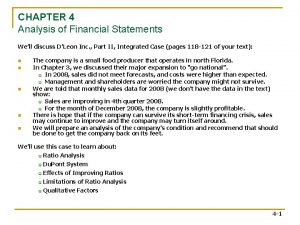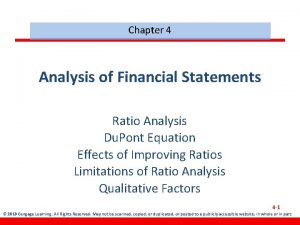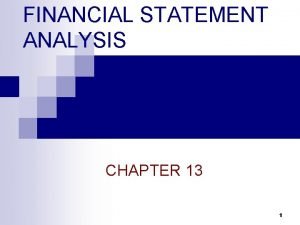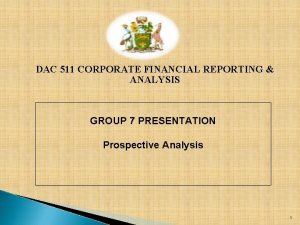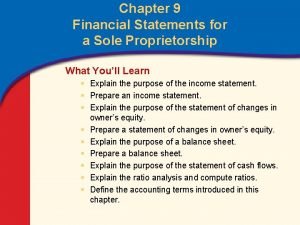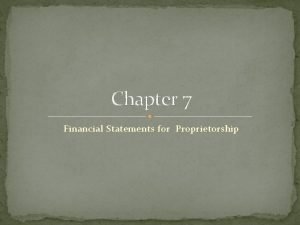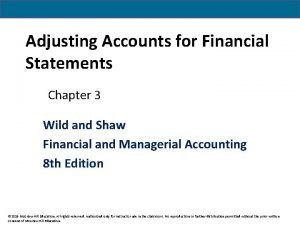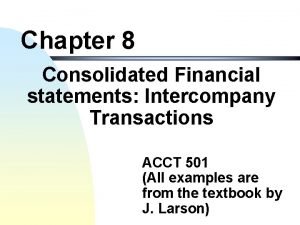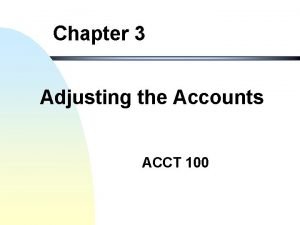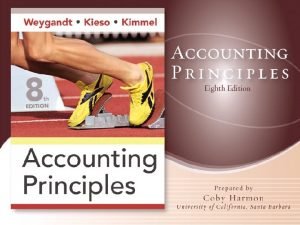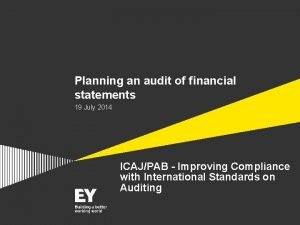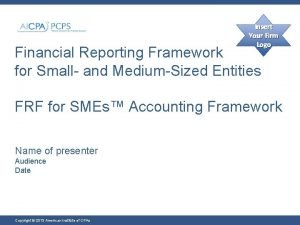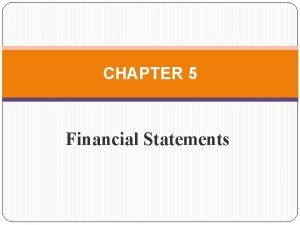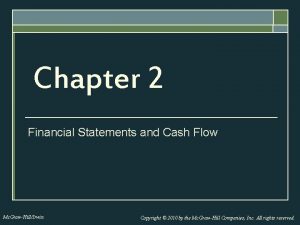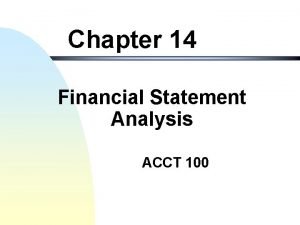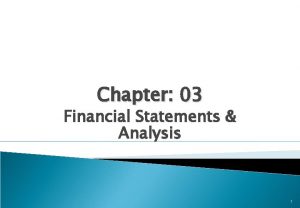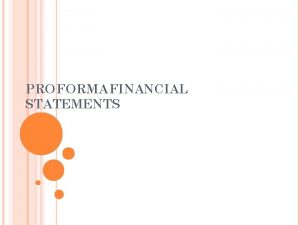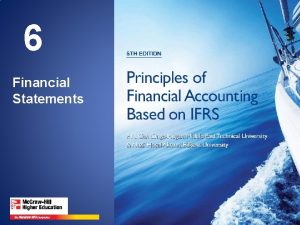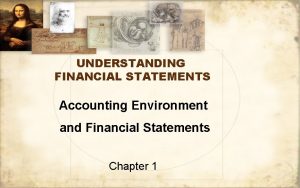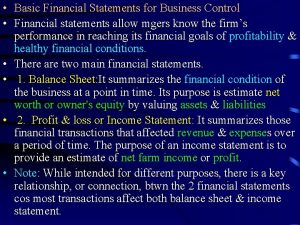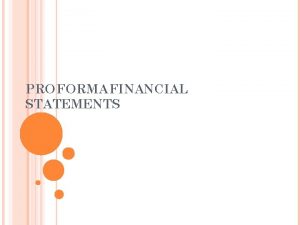Chapter 3 Financial Statements Analysis Mc GrawHillIrwin Copyright






















- Slides: 22

Chapter 3 Financial Statements Analysis Mc. Graw-Hill/Irwin Copyright © 2013 by The Mc. Graw-Hill Companies, Inc. All rights reserved.

3. 1 Financial Statements Analysis o Common-Size Balance Sheets n o Common-Size Income Statements n o o Compute all accounts as a percent of total assets Compute all line items as a percent of sales Standardized statements make it easier to compare financial information, particularly as the company grows. They are also useful for comparing companies of different sizes, particularly within the same industry. 3 -1

3. 2 Ratio Analysis o Ratios also allow for better comparison through time or between companies. o As we look at each ratio, ask yourself: How is the ratio computed? n What is the ratio trying to measure and why? n What is the unit of measurement? n What does the value indicate? n How can we improve the company’s ratio? n 3 -2

Categories of Financial Ratios o Short-term solvency or liquidity ratios o Long-term solvency or financial leverage ratios o Asset management or turnover ratios o Profitability ratios o Market value ratios 3 -3

PRUFROCK CORPORATION o o 33 million shares outstanding EPS = Earnings per Share EBIT = Earnings Before Interest and Taxes EBITDA = Earnings Before Interest, Taxes, Depreciation and Amortization n A proxy for “Free Cash Flow” which we will define (and use) later 3 -4

3 -5

3 -6

3 -7

3 -8

Computing Liquidity Ratios o Current n 708 / 540 = 1. 31 times o Quick n Ratio = (CA – Inventory) / CL (708 - 422) / 540 =. 53 times o Cash n Ratio = CA / CL Ratio = Cash / CL 98 / 540 =. 18 times 3 -9

Computing Leverage Ratios o Total n Debt Ratio = (TA – TE) / TA (3588 - 2591) / 3588 = 28% o Debt/Equity n (3588 – 2591) / 2591 = 38. 5% o Equity n = TD / TE Multiplier = TA / TE = 1 + D/E 1 +. 385 = 1. 385 3 -10

Computing Coverage Ratios o Times n Interest Earned = EBIT / Interest 691 / 141 = 4. 9 times o Cash Coverage = (EBIT + Depreciation + Amortization) / Interest n (691 + 276) / 141 = 6. 9 times 3 -11

Computing Inventory Ratios o Inventory Turnover = Cost of Goods Sold / Inventory n 1344 / 422 = 3. 2 times o Days’ Sales in Inventory = 365 / Inventory Turnover n 365 / 3. 2 = 114 days 3 -12

Computing Receivables Ratios o Receivables Turnover = Sales / Accounts Receivable n 2311 / 188 = 12. 3 times o Days’ Sales in Receivables = 365 / Receivables Turnover n 365 / 12. 3 = 30 days 3 -13

Computing Total Asset Turnover o Total Asset Turnover = Sales / Total Assets 2311 / 3588 =. 64 times n It is not unusual for TAT < 1, especially if a firm has a large amount of fixed assets. n 3 -14

Computing Profitability Measures o Profit Margin = Net Income / Sales n o Return on Assets (ROA) = Net Income / Total Assets n o 363 / 3588 = 10. 1% Return on Equity (ROE) = Net Income / Total Equity n o 363 / 2311 = 15. 7% 363 / 2591 = 14. 0% EBITDA Margin = EBITDA / Sales n 967 / 2311 = 41. 8% 3 -15

Computing Market Value Measures o o Market Capitalization = $88 per share x 33 million shares = 2904 million PE Ratio = Price per share / Earnings per share n o Market-to-book ratio = market value per share / book value per share n o 88 / (2591 / 33) = 1. 12 times Enterprise Value (EV) = Market capitalization + Market value of interest bearing debt – cash n o 88 / 11 = 8 times 2904 + (196 + 457) – 98 = 3465 EV Multiple = EV / EBITDA n 3465 / 967 = 3. 6 times 3 -16

Using Financial Statements o Ratios are not very helpful by themselves: they need to be compared to something o Time-Trend Analysis n Used to see how the firm’s performance is changing through time o Peer Group Analysis Compare to similar companies or within industries n SIC and NAICS codes n 3 -17

3. 3 The Du. Pont Identity o ROE = NI / TE o Multiply by 1 and then rearrange: ROE = (NI / TE) (TA / TA) n ROE = (NI / TA) (TA / TE) = ROA * EM n o Multiply by 1 again and then rearrange: ROE = (NI / TA) (TA / TE) (Sales / Sales) n ROE = (NI / Sales) (Sales / TA) (TA / TE) n ROE = PM * TAT * EM n 3 -18

Using the Du. Pont Identity o ROE = PM * TAT * EM Profit margin is a measure of the firm’s operating efficiency – how well it controls costs. n Total asset turnover is a measure of the firm’s asset use efficiency – how well it manages its assets. n Equity multiplier is a measure of the firm’s financial leverage. n 3 -19

The Du. Pont Identity for Prufrock o ROA = 10. 1% and EM = 1. 39 n o ROE = 10. 1% * 1. 385 = 14. 0% PM = 15. 7% and TAT = 0. 64 n ROE = 15. 7% * 0. 64 * 1. 385 = 14. 0% 3 -20

Potential Problems o o o There is no underlying theory, so there is no way to know which ratios are most relevant. Benchmarking is difficult for diversified firms. Globalization and international competition makes comparison more difficult because of differences in accounting regulations. Firms use varying accounting procedures. Firms have different fiscal years. Extraordinary, or one-time, events 3 -21
 Financial statements and ratio analysis chapter 3
Financial statements and ratio analysis chapter 3 Chapter 4 analysis of financial statements
Chapter 4 analysis of financial statements Chapter 4 analysis of financial statements
Chapter 4 analysis of financial statements How to improve current ratio
How to improve current ratio Analysis of financial statements
Analysis of financial statements Prospective analysis financial statements
Prospective analysis financial statements Financial analysis of banks
Financial analysis of banks Adjusting accounts for financial statements chapter 3
Adjusting accounts for financial statements chapter 3 Chapter 9 financial statements for a sole proprietorship
Chapter 9 financial statements for a sole proprietorship Sole proprietorship financial statements
Sole proprietorship financial statements Adjusting accounts for financial statements
Adjusting accounts for financial statements Intercompany bond transactions
Intercompany bond transactions Cffa finance formula
Cffa finance formula Working with financial statements chapter 3
Working with financial statements chapter 3 Chapter 3 adjusting accounts for financial statements
Chapter 3 adjusting accounts for financial statements Chapter 3 adjusting accounts for financial statements
Chapter 3 adjusting accounts for financial statements Financial report purpose
Financial report purpose Audit planning memorandum ey
Audit planning memorandum ey Sample notes to financial statements for small entities
Sample notes to financial statements for small entities Financial statement translation example
Financial statement translation example Objectives of financial statements
Objectives of financial statements Cash flow to creditors is equal to
Cash flow to creditors is equal to Where is preferred dividends on financial statements
Where is preferred dividends on financial statements

